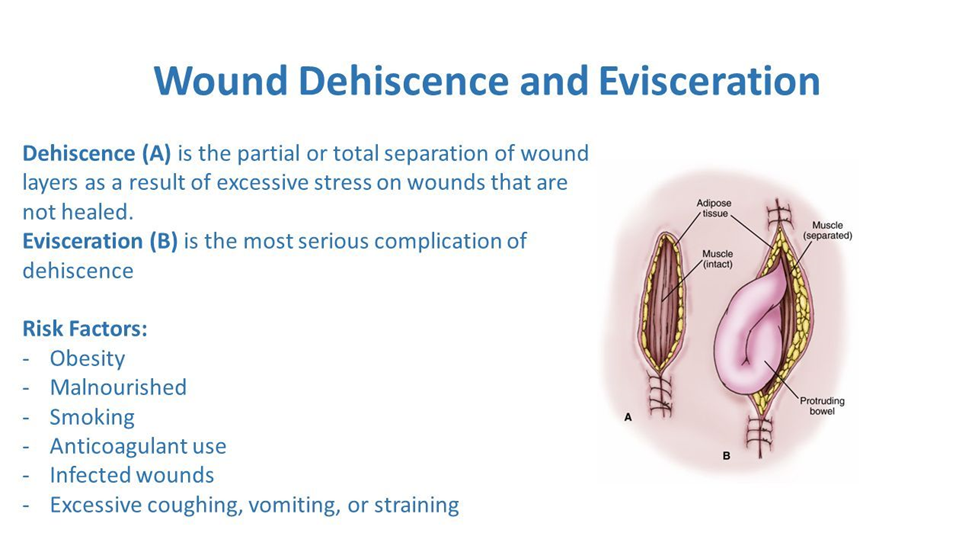A client who had colon surgery 3 days ago is anxious and requesting assistance to reposition. While the nurse is turning the client, the wound dehiscences and eviscerates. The nurse moistens an available sterile dressing and places it over the wound. Which intervention should the nurse implement next?
Prepare the client to return to the operating room.
Obtain a sample of the drainage to send to the lab.
Bring additional sterile dressing supplies to the room.
Auscultate the abdomen for bowel sound activity.
The Correct Answer is A
A. Prepare the client to return to the operating room:
This is the correct and immediate priority. Evisceration, where internal organs protrude through the surgical incision, is a surgical emergency. Returning the client to the operating room is necessary to assess the extent of the complication, address the wound dehiscence, and protect the exposed organs. This intervention aims to prevent further complications and provide necessary surgical interventions.
B. Obtain a sample of the drainage to send to the lab:
While obtaining samples for laboratory analysis can be important for infection control, in the context of a client with evisceration, the primary concern is the surgical emergency. The priority is to address the wound complication by returning to the operating room rather than focusing on laboratory analysis at this immediate moment.
C. Bring additional sterile dressing supplies to the room:
While bringing additional supplies may be necessary, the priority in this situation is to prepare for the client's return to the operating room. Once the client is in a controlled surgical environment, additional dressing changes and wound care can be performed as needed.
D. Auscultate the abdomen for bowel sound activity:
While monitoring bowel sounds is a routine nursing assessment, in the context of evisceration, the immediate concern is the exposure of internal organs and the risk of infection. Preparing for the operating room takes precedence over routine assessments.

Nursing Test Bank
Naxlex Comprehensive Predictor Exams
Related Questions
Correct Answer is D
Explanation
A. Assess client for signs and symptoms of upper airway infection:
While upper airway infections can contribute to respiratory symptoms, the client's history of asthma and the exacerbation of symptoms during exercise suggest that asthma management should be a priority.
B. Determine if the client is using an inhaler before exercising:
This is a relevant consideration, and ensuring proper pre-exercise use of bronchodilators (such as an inhaler) is an important aspect of asthma management. However, the question is broader and involves a review of the client's overall asthma management.
C. Teach client to use pursed lip breathing when episodes occur:
Pursed lip breathing is a technique that can help manage symptoms, especially during episodes of bronchoconstriction. However, the focus here is on a more comprehensive assessment and review of the client's routine asthma management.
D. Review the client's routine asthma management prescriptions:
This is the correct answer. The client's reported symptoms during exercise suggest a potential need for adjustments to the routine asthma management plan. Reviewing the client's prescriptions, including the type and timing of medications, can help ensure optimal control of symptoms, especially during physical activity.
Correct Answer is D
Explanation
A. Guidelines for oxygen use:
While guidelines for oxygen use are important, addressing the root cause of the respiratory condition, which includes smoking cessation, is crucial for long-term management.
B. Methods for weight loss:
Obesity can contribute to respiratory issues, but in the immediate context of emphysema exacerbation and the need for oxygen therapy, smoking cessation is a more urgent concern.
C. Approaches to conserve energy:
Conserving energy is important for clients with emphysema, but addressing the impact of smoking on respiratory function is a more immediate priority.
D. Strategies for smoking cessation.
Smoking is a major contributor to the progression of emphysema and exacerbation of respiratory symptoms. Addressing smoking cessation is crucial in improving the client's respiratory function and overall health. Continuing to smoke can exacerbate emphysema and compromise the effectiveness of other interventions, including oxygen therapy.
Whether you are a student looking to ace your exams or a practicing nurse seeking to enhance your expertise , our nursing education contents will empower you with the confidence and competence to make a difference in the lives of patients and become a respected leader in the healthcare field.
Visit Naxlex, invest in your future and unlock endless possibilities with our unparalleled nursing education contents today
Report Wrong Answer on the Current Question
Do you disagree with the answer? If yes, what is your expected answer? Explain.
Kindly be descriptive with the issue you are facing.
